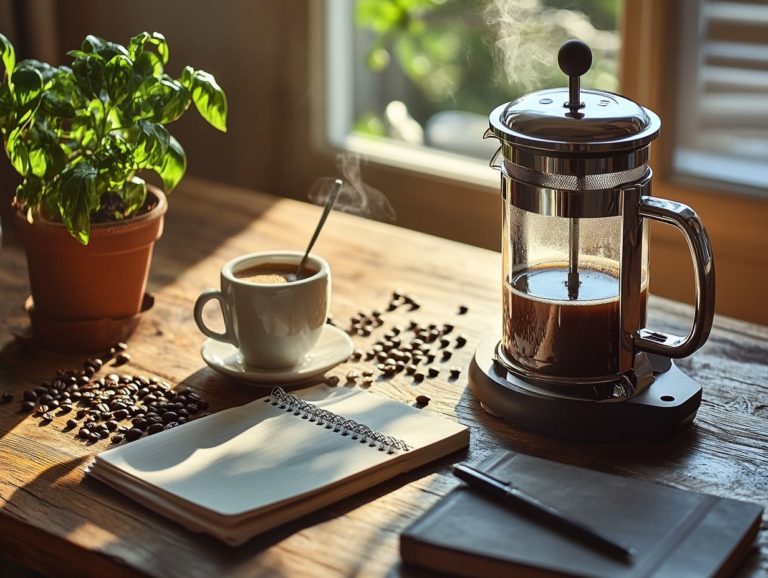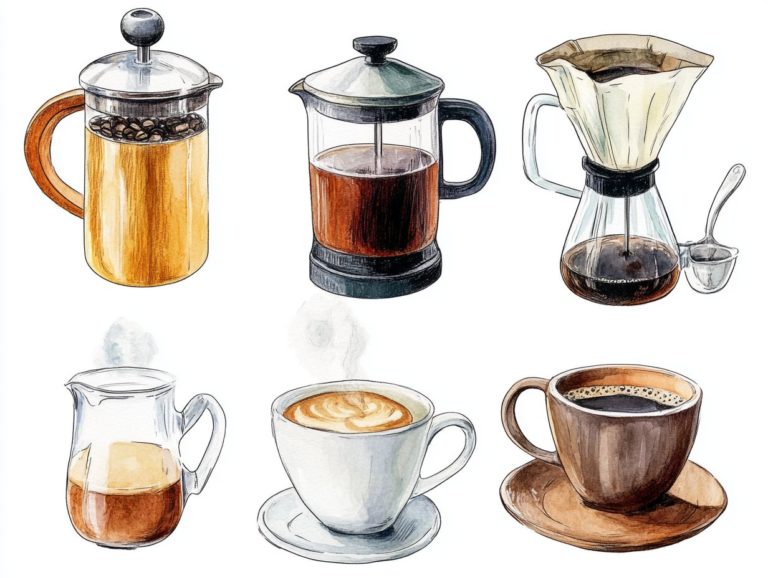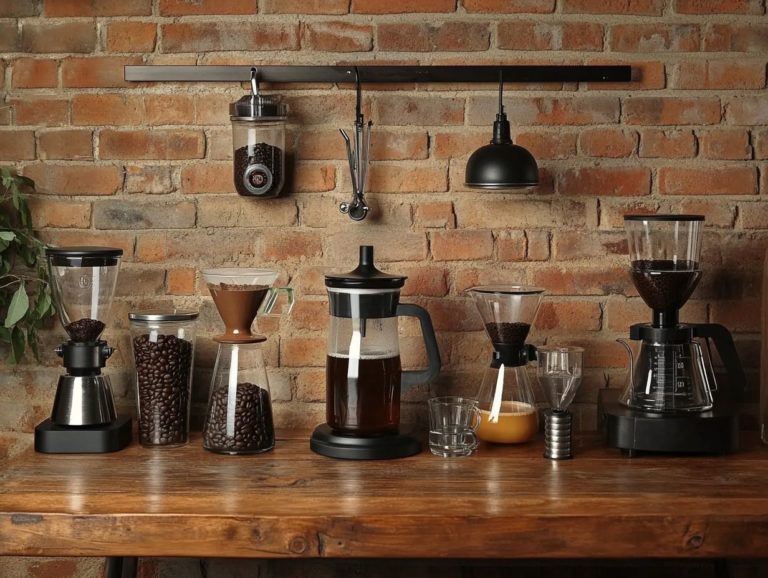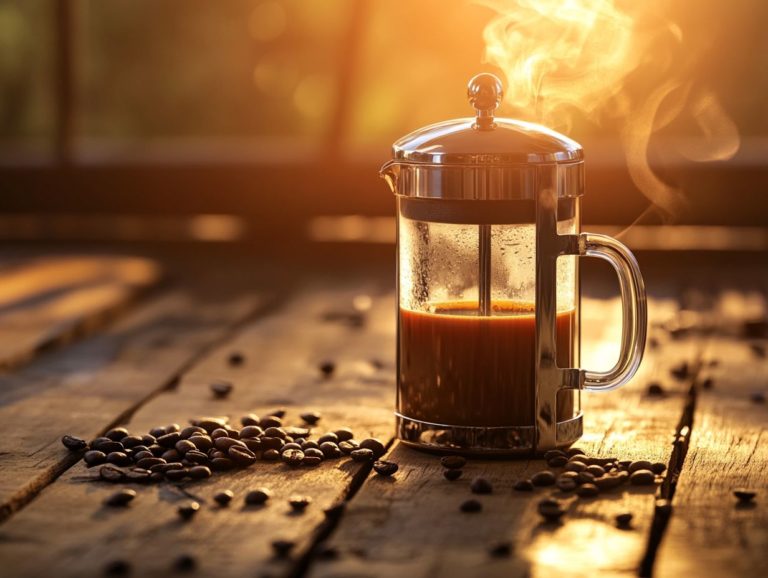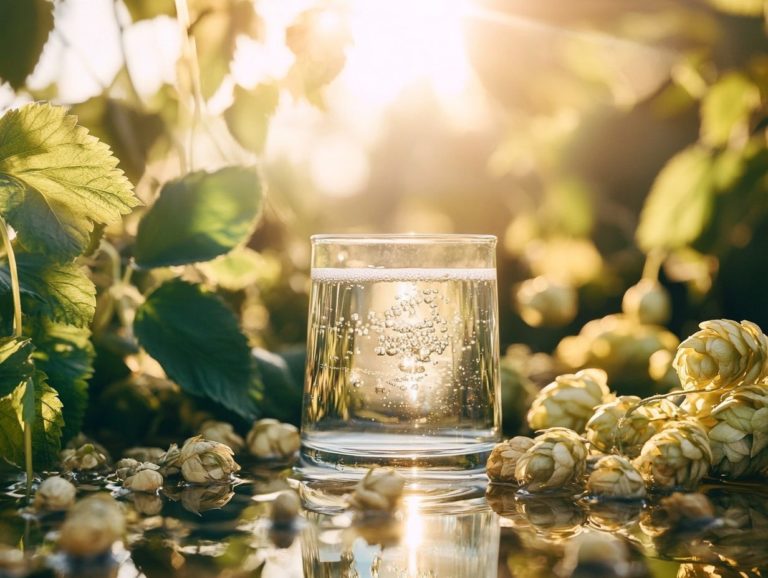Brewing Techniques for a Richer Coffee Experience
When you’re on a quest to brew the perfect cup of coffee, many factors come into play. One often overlooked aspect is the quality of water, which can greatly impact your coffee.
The flavor of your coffee is influenced by everything from the coffee beans to the brewing method. This article will help you discover the key elements that shape coffee taste, including grind size, water temperature, and brewing time.
You’ll learn about various brewing techniques like French press, AeroPress, and pour-over. Get ready to enhance your coffee experience!
Contents
- Key Takeaways:
- The Importance of Water Quality in Coffee Brewing
- Factors Affecting the Taste of Coffee
- 1. Coffee Beans
- 2. Grind Size
- Different Brewing Techniques
- 5. AeroPress
- Tips for a Richer Coffee Experience
- 1. Use Freshly Roasted Beans, such as those from Glory Cloud Coffee
- 2. Grind Your Own Beans
- 3. Experiment with Different Brewing Methods
- Frequently Asked Questions
- What are some key brewing techniques for a richer coffee experience?
- How does grinding your own beans affect the taste of coffee?
- Why is a French press a popular choice for brewing coffee?
- What are some other brewing methods to try for a richer coffee experience?
- How Can I Enhance the Flavor of My Coffee Through Brewing Techniques?
- Is It Necessary to Invest in Expensive Equipment for a Richer Coffee Experience?
Key Takeaways:
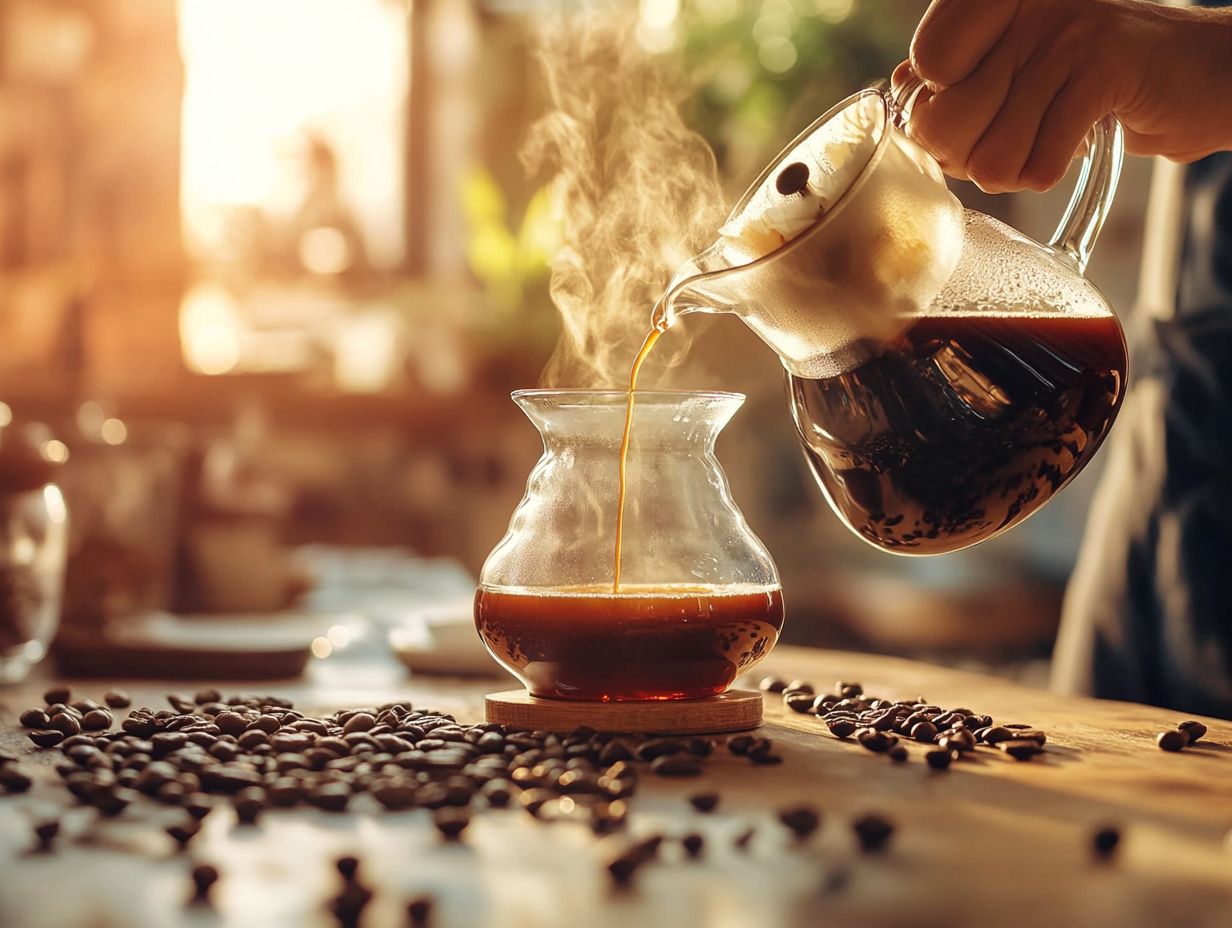
- Water quality is crucial for a rich coffee experience. Invest in filtered or bottled water to improve taste.
- The type of beans, grind size, water temperature, brewing time, and water-to-coffee ratio all affect flavor clarity.
- Experiment with brewing techniques like French press, pour-over, and AeroPress to enhance your coffee journey.
The Importance of Water Quality in Coffee Brewing
Coffee lovers know that water quality is vital in the brewing process. It directly affects how flavors are drawn from the beans.
Using high-quality water enhances flavor by balancing minerals and eliminating impurities. This detail is crucial for those seeking consistency and clarity in every cup.
The right water temperature and composition can elevate your brewing method. Whether you prefer pour-over, French press, or espresso, good water makes a difference.
Factors Affecting the Taste of Coffee
Several factors shape the taste of coffee. The quality and type of coffee beans, whether it’s Arabica or blends like Glory Cloud Coffee, influence flavor clarity.
Grind size significantly affects flavor. It dictates how well flavors are drawn out from the coffee beans, along with water temperature and brewing time.
The coffee-to-water ratio is also critical; it can elevate or diminish the final product. Achieve the desired taste and aroma in every cup!
1. Coffee Beans
Coffee beans serve as the essential foundation of any remarkable brew. Their origin, roast level, and processing method play crucial roles in shaping the final flavor profile.
If you lean towards Arabica beans, you’re embracing nuanced flavors and higher acidity. This makes them a go-to choice for coffee aficionados who prefer light and medium roasts.
On the other hand, if you favor a bolder flavor, dark roast coffee beans might be your ideal match. They offer a rich, full-bodied cup that satisfies your cravings.
The selection of beans profoundly influences your coffee experience, determining the taste and aroma of each brewed beverage. Consider the rich tapestry of coffee origins, like those from Brazil, particularly Rosa Morena, or Guatemala Huehuetenango.
Here, geographical nuances contribute to distinct tastes that are truly captivating. Brazilian Arabica beans typically present a sweet and smooth profile, enhanced by delightful notes of chocolate and nut.
The roasting process can dramatically transform these flavors. Light roasts preserve the beans’ unique characteristics, leading to vibrant fruit notes, while medium roasts often strike a harmonious balance between sweetness and acidity.
Dark roasts, in contrast, introduce deeper, smokier flavors that can sometimes overshadow the bean’s innate qualities. By understanding these variations, you can explore the exciting world of coffee.
2. Grind Size
Grind size plays a crucial role in your coffee preparation process, directly impacting how flavors are drawn out and flavor consistency. Choosing a finer grind is perfect for brewing methods that rely on pressure, like espresso.
A coarser grind is your go-to for immersion methods such as French press or cold brew. Getting the grind size right ensures that your coffee s unique flavors are fully extracted, allowing you to savor a clean cup free from bitterness.
Getting grind size right will take your coffee game to the next level! For instance, when you re using pour-over techniques, a medium grind is generally the sweet spot to optimize flow rate and flavor extraction.
The Chemex, with its thicker paper filters, benefits from a slightly coarser grind to prevent potential over-extraction while still delivering a bright, flavorful cup. Methods such as the Kalita Wave and Clever Dripper bring unique flavor profiles based on the grind recommendation.
The AeroPress offers versatility, allowing you to play with a fine to medium grind depending on whether you prefer a short or long brew time. Ultimately, experimenting with grind sizes tailored to each brewing method enables you to refine your desired flavor profile, achieving that perfect balance of clarity and richness in every cup.
Don’t miss out on these flavor profiles! Try different beans and grind sizes to discover what suits your taste best.
Understanding Water Temperature for Coffee
Ever wondered how water temperature can change your coffee experience? Water temperature is crucial in the art of coffee extraction, wielding significant influence over the flavor and aroma of your final brew. For most brewing methods, aim for a water temperature between 195 F and 205 F (90 C to 96 C). This range allows for the optimal extraction of flavors while preventing over-extraction or scalding your coffee beans.
Whether you’re employing a pour-over technique or indulging in an immersion method like the French press, maintaining the right temperature is essential to achieving the taste you desire and preserving the rich nuances of the coffee. Mastering this detail can truly elevate your coffee experience.
For example, with the pour-over method, slightly lowering the temperature can enhance those delightful floral notes. Meanwhile, the French press thrives on hotter water for a bolder flavor profile. In terms of espresso, getting the temperature right is crucial: water that’s too hot can introduce bitterness, while water that’s too cold can lead to a sour brew.
To ensure consistency in your brewing, consider investing in a kettle with temperature control or using a thermometer to monitor your water temperature carefully. By taking the time to control your water temperature, you can brew coffee that truly showcases the best flavors of your beans.
Mastering Brewing Time
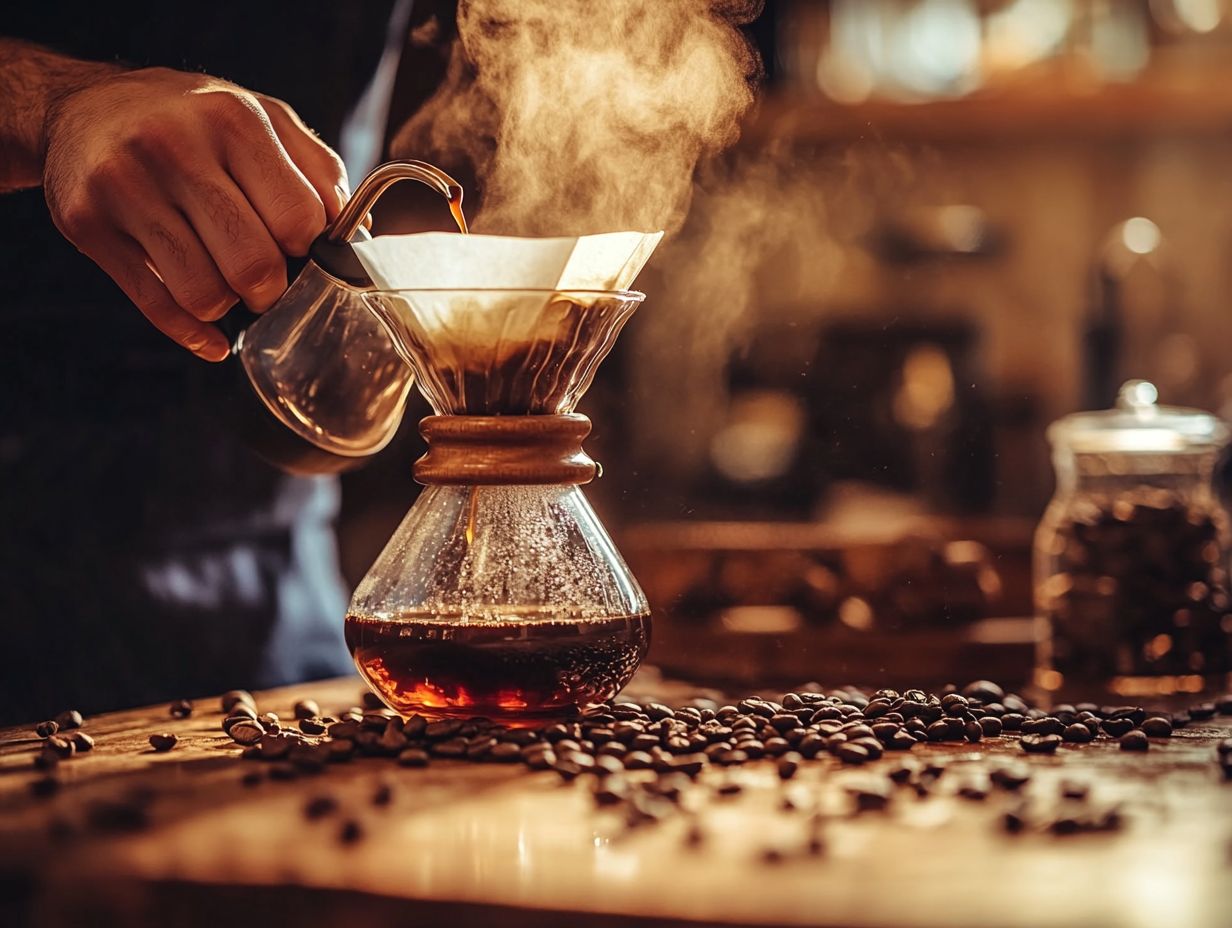
Don’t miss out on the perfect cup! Brewing time is a crucial element in the coffee-making process, directly influencing the extraction and the flavor profile of your beverage. Depending on the brewing method you choose whether it’s a pour-over or cold brew the ideal brewing time can vary significantly, helping you get a consistent and delicious cup.
- Pour-over: typically takes about 2-4 minutes.
- Cold brew: demands a longer wait of 12-24 hours to achieve that rich, smooth coffee concentrate.
- French press: a brewing time of around 4 minutes usually delivers a robust flavor.
- AeroPress: brew time ranges from 30 seconds to 1 minute, dramatically changing the cup’s profile based on the beans you select.
It’s also essential to consider the roast level and origin of your coffee. Lighter roasts often shine with shorter brew times, while darker roasts may benefit from slightly extended extraction to fully develop their deeper flavors.
Understanding these nuances helps you craft your perfect cup. Tailor each brew to your preferences and the unique qualities of your favorite beans, enhancing your coffee rituals.
5. Water-to-Coffee Ratio
Understanding the Water-to-Coffee Ratio
The water-to-coffee ratio is a crucial element in the brewing process that dictates the strength and flavor clarity of your coffee. A widely recommended starting point is a ratio of 1:15 (1 gram of coffee to 15 grams of water). This ratio can certainly fluctuate based on your personal taste preferences and the brewing method you choose whether it s the French press, pour-over, AeroPress, Moka pot, or Siphon brewers.
By adjusting this ratio, you can refine your coffee experience, striking the perfect balance between boldness and subtlety in every cup, achieving rich flavor and aroma.
For example, if you re using a French press, you might opt for a slightly coarser grind with a 1:12 ratio to enhance richness and deliver a more robust flavor. On the other hand, the pour-over method, known for its precision in water distribution, often flourishes with a 1:16 ratio, resulting in a brighter and more nuanced flavor profile.
Many baristas enjoy experimenting within these ranges, knowing that even minor adjustments can lead to significant shifts in taste. By paying attention to these ratios, coffee enthusiasts and professionals can elevate their brewing techniques, ensuring each cup meets personal expectations while highlighting the unique characteristics of the coffee beans, whether they are light roast, medium roast, or dark roast.
Different Brewing Techniques
Different brewing techniques present unique ways to extract flavors from coffee beans, each significantly impacting the taste and aroma of your final cup. Dive into the world of flavors and aromas that each brewing method can unveil!
From the immersive experience of the French press to the precision of pour-over and the effortless convenience of AeroPress, every method invites you to explore a diverse array of flavor profiles and coffee experiences. Each brewing method, like the Chemex or Kalita Wave, offers an adventure into the intricate world of coffee brewing.
Cold brew, with its smooth and rich flavor, distinguishes itself as a refreshing alternative, showcasing the versatility inherent in manual brewing methods and the artistry that defines coffee making. Cold brew s low acidity and bold flavor make it a favorite among coffee enthusiasts for warm weather coffee enjoyment.
By understanding these techniques, you not only enrich your appreciation of coffee culture but also elevate your enjoyment of every brew.
1. French Press
The French press, an immersion brewing method where coffee grounds steep in water, stands out as a beloved method, celebrated for its ability to craft a rich, full-bodied coffee with a bold flavor profile. When you steep coarsely ground coffee beans in hot water for several minutes before pressing down the plunger, you get the best taste and aroma from the coffee, leading to a truly unique experience.
Coffee enthusiasts appreciate the French press for its straightforward approach and the precise control it offers over brewing time and water temperature. This makes it a favored choice for both casual drinkers and skilled baristas alike.
To achieve outstanding results, precision in grind size is essential; opting for a coarser grind prevents over-extraction and ensures a smoother taste. Aim for a brew time of around four to five minutes, allowing the coffee to fully blossom without veering into bitterness. Pay attention to water temperature as well; targeting approximately 200 F is crucial for unlocking complex flavor notes without scalding the grounds.
Feel free to experiment with different coffee beans and adjust these variables to discover an exquisite range of flavors, from nutty to fruity, transforming your entire brewing experience into a delightful adventure. Whether you try Arabica beans from Brazil Rosa Morena or Guatemala Huehuetenango, each choice offers a new journey in coffee mastery.
2. Pour Over
Pour-over brewing is a careful process that grants you extraordinary flavor clarity and full control over your coffee-making process. By gently pouring hot water over freshly ground coffee beans in a dripper like the Chemex or Kalita Wave, you can skillfully manipulate essential factors such as water temperature and brew time. This precision allows you to craft a clean cup that truly highlights the intricate nuances of your coffee’s flavor profile. It s no surprise that this method is a favorite among serious coffee lovers and baristas, as it showcases the unique characteristics of each coffee bean, promising a delightful experience with every sip.
Achieving a premium coffee experience often involves a keen understanding of each brewing step and how it influences the final taste.
The beauty of pour-over brewing lies in its precision; even the slightest adjustments can profoundly influence the final brew. Begin by selecting the appropriate grind size typically, a medium-fine grind is ideal as it encourages even extraction while maintaining a luxurious mouthfeel.
Water temperature also plays a crucial role. Aim for a range between 195 F and 205 F to optimally extract flavor without introducing unwelcome bitterness. Paying attention to the coffee-to-water ratio can elevate your brew to new heights; a common guideline is to use one gram of coffee for every 15-17 grams of water. For a richer flavor profile, consider experimenting with different coffee beans like Big Trouble or Hologram blends.
Dive into experimentation with these variables to unlock a consistently rich and aromatic cup that truly celebrates the essence of the beans.
3. Drip Coffee
Drip coffee is a crowd favorite that perfectly balances convenience with consistent flavor extraction, making it a staple in many households. With an automatic coffee brewer, you simply heat water and let it drip over ground coffee, resulting in a controlled and straightforward brewing process. While it may not deliver the same depth of flavor as manual methods like pour-over or French press, drip coffee machines excel in efficiency and ease of use, perfectly catering to busy coffee lovers like you who crave a reliable cup each morning. The consistency of drip coffee makes it an excellent choice for those who appreciate a balanced coffee experience.
To achieve that perfect cup, you need to pay attention to several variables that can significantly influence the final taste. Grind size is crucial; a finer grind can lead to over-extraction, while a coarser grind might leave you with a watery brew. Water temperature is another key factor keep it between 195 F and 205 F to properly extract the coffee’s oils and flavors without scalding the grounds. Brew time matters too; if your brewing duration is too short, you ll end up with weak coffee, whereas too long can introduce those unwelcome bitter notes.
And let’s not overlook the importance of selecting the right type of coffee beans. Different varietals and roast levels can completely transform your experience, offering unique flavor profiles that range from rich chocolatey undertones to bright, fruity notes, ensuring that every cup is both enjoyable and nuanced.
4. Cold Brew
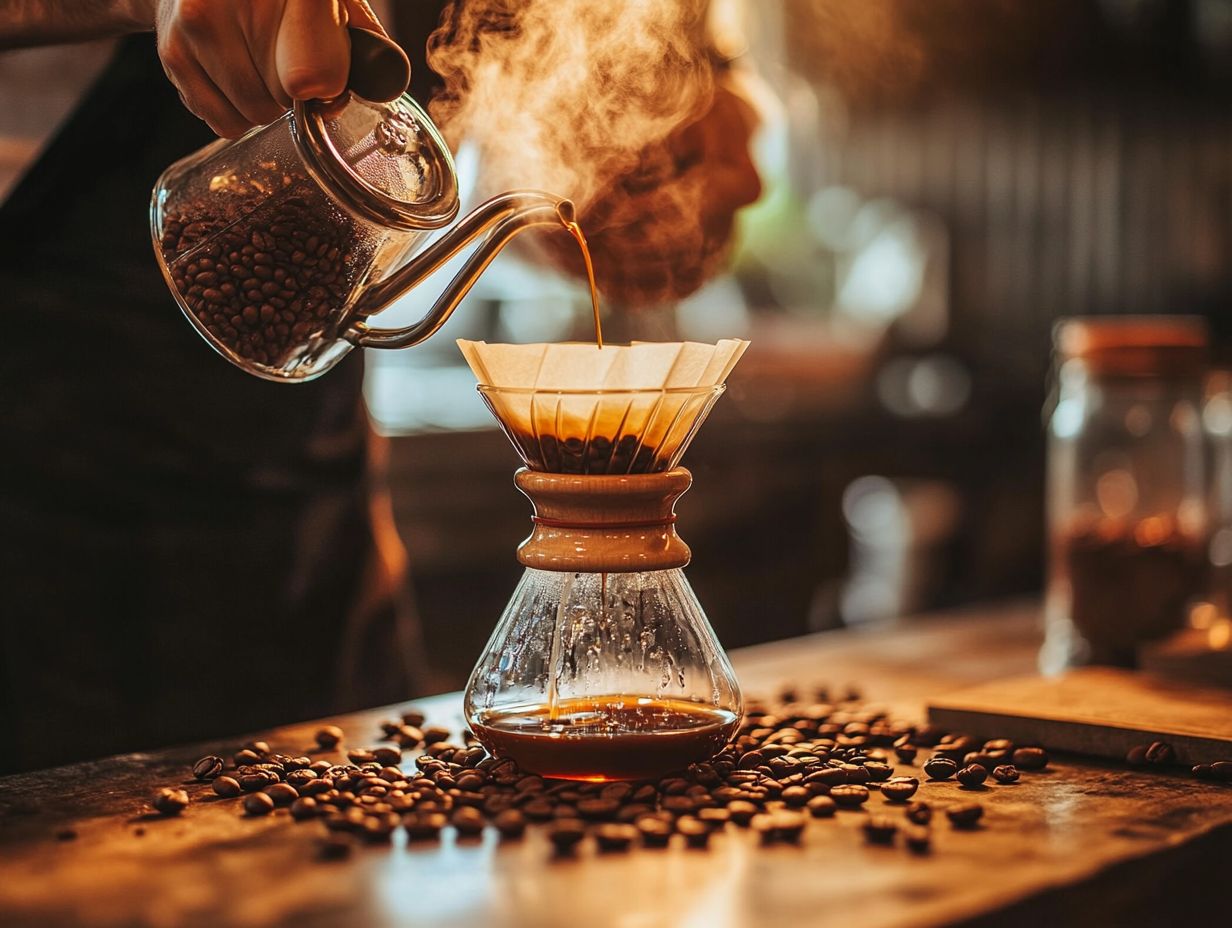
Cold brew is not just another coffee; it’s a unique brewing method that invites you to steep coarsely ground coffee beans in cold water for an extended period typically 12 to 24 hours. This process yields a smooth and rich coffee concentrate that coffee aficionados rave about. With this immersion technique, you experience a different way of drawing out flavors, highlighting low acidity and a bold flavor profile that many appreciate.
The beauty of cold brew lies in its versatility. You can enjoy it straight or dilute it with water or milk, making it your go-to refreshment on hot days!
For the best results, aim for a coffee-to-water ratio of about 1:4 for that concentrated brew. Adjust the dilution based on your personal taste after brewing. The grind size plays a pivotal role in your final cup. Coarser grinds are your best bet, as they promote efficient extraction without the risk of over-extraction that can ruin the flavor when using finer grinds.
Steeping time is crucial here; stick to the 12-24 hour window to extract rich flavors while keeping bitterness at bay. Compared to traditional hot brewing methods, cold brew offers a smoother, less acidic taste profile, making it a refreshing alternative. Cold brew isn’t just about convenience; it highlights the versatility and artistry involved in coffee preparation.
For serving suggestions, consider pouring it over ice, adding some flavored syrups, or indulging in a splash of cream for a delightful treat.
5. AeroPress
The AeroPress stands out as a versatile brewing method that expertly combines immersion and pressure. This allows you to create a remarkable array of coffee flavors and styles. By applying pressure to hot water and coffee grounds within its cylindrical chamber, you can craft everything from espresso-like coffee to rich, full-bodied brews.
This method is cherished by coffee enthusiasts for its ability to deliver a clean cup with exceptional flavor clarity while inviting experimentation with grind size and brewing time. It’s a go-to choice for both baristas and home brewers. The AeroPress embodies the spirit of coffee mastery, offering a unique flavor journey with every brew.
Its design encourages creativity, enabling you to tweak your brewing variables to achieve your ideal cup. This could mean using finely ground coffee for a robust shot or opting for a coarser grind for a milder, smoother experience. The recommended coffee-to-water ratio typically falls between 1:15 to 1:17, depending on your strength preference.
Playing with these parameters unlocks a spectrum of flavor profiles, ranging from fruity and vibrant to deep and chocolatey. Unlike traditional brewing methods, the AeroPress allows for swift extraction of flavors while preserving the integrity of the beans, making it an intriguing choice for anyone eager to explore the nuanced world of coffee.
Tips for a Richer Coffee Experience
To elevate your coffee experience, consider implementing a few practical tips that can profoundly enhance the flavor and aroma of your brew.
Start by selecting freshly roasted beans to ensure that the coffee retains its natural oils and rich flavors. This results in a vibrant taste that truly delights the senses.
Grinding your own beans just before brewing is another excellent strategy. This maximizes freshness and flavor extraction, enriching your overall enjoyment. It ensures that the grind size is perfectly suited to your chosen brewing method, whether you’re using a French press, AeroPress, or pour-over.
Don’t hesitate to experiment with various brewing methods. Pay close attention to factors such as water quality, temperature, and brewing time, as these elements play a crucial role in refining your coffee experience.
1. Use Freshly Roasted Beans, such as those from Glory Cloud Coffee
Using freshly roasted beans is one of the most effective ways to elevate the flavor profile and overall quality of your coffee. Freshly roasted beans retain their essential oils and aroma, contributing to a vibrant and rich flavor experience that often disappears in pre-packaged or older beans. For true coffee aficionados, selecting beans from reputable roasters, such as those sourced from Brazil Rosa Morena, Big Trouble, or Guatemala Huehuetenango, ensures that your coffee experience reaches new heights with every brew.
To fully capitalize on the potential of freshly roasted coffee, pay close attention to the roast date and choose beans roasted within the past two weeks. This short window guarantees the fullest expression of flavor and aroma.
When shopping, seek out local roasters or specialty coffee shops that prioritize quality and transparency. Look for blends like Arabica, known for its sweet flavor and smooth finish, or Hologram for a unique flavor experience. Once you’ve found your ideal beans, proper storage becomes essential. Keep them in an airtight container, away from light, heat, and moisture, to preserve their integrity for as long as possible.
By incorporating these practices, you can indulge in an extraordinary coffee experience with every cup, whether you prefer a light roast, medium roast, or dark roast.
2. Grind Your Own Beans
Grinding your own beans is a straightforward yet great practice that can significantly elevate the clarity of flavors and the overall coffee-making experience. By grinding your beans just before brewing, you capture the freshest flavors and aromas, ensuring that each cup embodies the unique characteristics of the coffee you ve chosen. This allows coffee enthusiasts to tailor their grind size for optimal extraction and flavor clarity.
Whether you prefer a fine grind for an espresso or a coarser grind for a French press, adjusting the grind size to match your brewing method enhances the entire coffee journey, delivering a more delightful taste in every sip.
Different grind sizes play a crucial role in the extraction process during brewing. Finer grounds tend to extract more quickly, resulting in a bolder flavor, while coarser grounds allow for a slower extraction, unveiling more delicate and nuanced flavors. Adjusting the grind size is essential for achieving the desired coffee-to-water ratio and overall flavor profile.
If you re considering investing in a grinder, opting for a burr grinder is a wise choice over a blade grinder, as burr grinders provide a consistent particle size, which is essential for balanced extraction.
Experimenting with various grind sizes helps uncover the optimal settings that cater to your personal preferences, ultimately leading to a richer, more satisfying coffee experience with each morning brew.
3. Experiment with Different Brewing Methods
Experimenting with different brewing methods is an exhilarating way to uncover new flavor profiles and elevate your coffee experience. Each technique, whether it s the hands-on approach of the French press, the meticulous nature of pour-over, the consistency of a Kalita Wave, or the simplicity of the AeroPress, brings its own unique characteristics that can completely transform the taste and aroma of your brew.
By exploring various methods and fine-tuning elements like grind size, water temperature, and brewing time, you can customize your coffee experience to match your distinct preferences, incorporating brewing techniques to enhance your morning routine.
Diving into these diverse brewing techniques not only helps you refine your palate but also allows you to appreciate the nuances that different methods can reveal. For example, using a Chemex might showcase delightful floral notes, while a cold brew could bring forth rich chocolate undertones. Manual brewing methods like a Clever Dripper or a Moka pot can also enhance the coffee journey.
Start your exciting coffee journey today! Begin with a basic setup and gradually incorporate new tools and techniques into your routine. Consider adding pressure-based methods like a siphon brewer or improving your barista skills for a more immersive experience.
Consider joining local coffee workshops or engaging with online communities; they can provide invaluable insights and support, deepening your connection to the fascinating world of coffee. These resources enhance your brewing skills and improve your coffee mastery.
4. Pay Attention to Water Quality
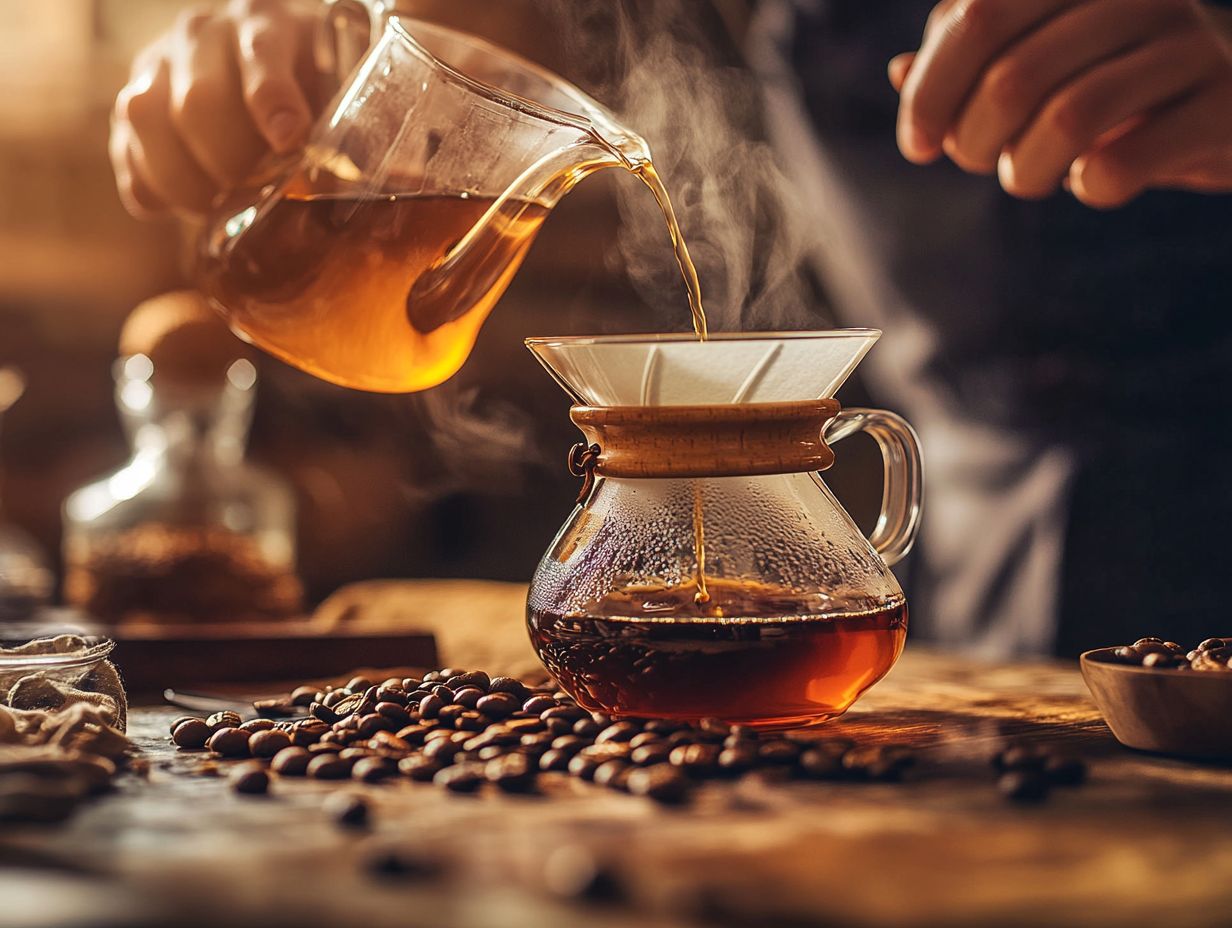
Paying attention to water quality is essential for brewing exceptional coffee, as it significantly influences the flavor profile and overall experience. By opting for filtered or bottled water, you can eliminate impurities that may compromise taste, allowing the natural flavors of the coffee beans to shine through.
As a coffee enthusiast, understanding how mineral content and pH levels (which measure how acidic or alkaline the water is) affect your brew can enhance your coffee-making journey, elevating each cup to new heights. The right water composition can bring out a clean cup and the unique flavor of premium coffee beans.
Different brewing methods require specific water characteristics. For example, light-bodied coffees thrive with soft water, while bolder varieties benefit from a mineral-rich option that enhances taste complexity.
When choosing water, take note of its mineral composition calcium and magnesium add sweetness, while sodium can elevate mouthfeel. Look for water with a neutral pH of around 7 to unlock the true flavors of your brew, as extremes can obscure the delicate flavors of your coffee.
For the best results, don’t hesitate to experiment with various water types, including testing your tap water to assess its suitability. Adjust accordingly to achieve that perfect brew that delights your senses. This practice can be pivotal for coffee lovers seeking to refine their coffee rituals and enjoy consistently delightful preparation.
5. Keep Your Equipment Clean
Maintaining cleanliness of your coffee brewing equipment is crucial for achieving flavor clarity and ensuring best results during preparation. Over time, residual oils and coffee grounds can accumulate, negatively impacting the taste of your brew and diminishing your overall coffee experience.
For those who truly appreciate the art of coffee, regularly cleaning equipment like grinders, brewers, and filters is essential to preserving the integrity of their chosen brewing methods. This way, each cup can genuinely reflect the rich flavors of the coffee beans, whether you’re using a French press, Chemex, or pour-over.
When you neglect your equipment, it affects the taste and can also lead to malfunctioning devices that disrupt the brewing process. Committing to a deep clean of your coffee grinder every few weeks prevents oils from becoming rancid, while regularly descaling your espresso machine enhances extraction quality. It s also vital to wash brew baskets and carafes promptly to eliminate any leftover residue. Clean equipment ensures you capture the full-bodied aroma and flavor clarity with each brew.
By incorporating these straightforward cleaning practices into your routine, you can significantly elevate your brewing ritual, allowing you to fully indulge in the rich notes and aromatic complexities that your selected beans have to offer.
For more inspiration, check out brewing guides and techniques from Glory Cloud Coffee.
Frequently Asked Questions
What are some key brewing techniques for a richer coffee experience?
Key brewing techniques include proper coffee-to-water ratios and paying close attention to water temperature for optimal extraction. Grinding your own beans and experimenting with different methods such as pour-over or cold brew can also enhance your experience.
How does grinding your own beans affect the taste of coffee?
Grinding your own beans allows for a fresher and more consistent grind, resulting in a more flavorful cup of coffee. It also allows you to adjust the grind size to your personal preference, which is vital for achieving the best flavor.
Why is a French press a popular choice for brewing coffee?
A French press is a staple in manual brewing, often recommended for those looking to explore barista skills at home. It allows for a full immersion brewing process, resulting in a bold and rich cup of coffee and offers more control over brewing time and temperature.
What are some other brewing methods to try for a richer coffee experience?
Additional methods include immersion techniques like siphon brewers, providing an engaging coffee preparation experience. Other popular brewing methods include pour-over, which allows for a clean and smooth cup of coffee, and cold brew, producing a less acidic and more concentrated coffee.
Dive into the exciting world of coffee brewing today and transform your mornings!
How Can I Enhance the Flavor of My Coffee Through Brewing Techniques?
Adjusting your grind size can enhance the flavor of your coffee. Grind size refers to how finely or coarsely you grind your coffee beans.
Experimenting with different brewing methods will help you find the perfect balance of bold flavors and unique notes. Using a paper filter is another great way to improve flavor, as it removes oils and sediments that can make coffee taste bitter.
Try different water temperatures and ratios, as these can significantly affect the flavor of your coffee.
Is It Necessary to Invest in Expensive Equipment for a Richer Coffee Experience?
No, you don t need expensive equipment for a rich coffee experience. You ll be amazed at how budget-friendly tools like a simple pour-over set or stovetop espresso maker can unlock rich flavor and consistency in every cup!

